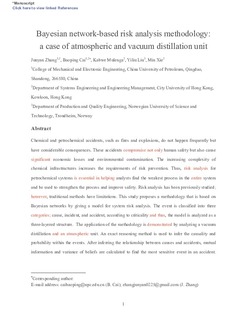| dc.contributor.author | Zhang, Junyan | |
| dc.contributor.author | Cai, Baoping | |
| dc.contributor.author | Mulenga, Kabwe | |
| dc.contributor.author | Liu, Yiliu | |
| dc.contributor.author | Xie, Min | |
| dc.date.accessioned | 2019-02-22T10:09:22Z | |
| dc.date.available | 2019-02-22T10:09:22Z | |
| dc.date.created | 2018-08-15T13:47:14Z | |
| dc.date.issued | 2018 | |
| dc.identifier.citation | Process Safety and Environmental Protection. 2018, 117 660-674. | nb_NO |
| dc.identifier.issn | 0957-5820 | |
| dc.identifier.uri | http://hdl.handle.net/11250/2586985 | |
| dc.description.abstract | Chemical and petrochemical accidents, such as fires and explosions, do not happen frequently but have considerable consequences. These accidents compromise not only human safety but also cause significant economic losses and environmental contamination. The increasing complexity of chemical infrastructures increases the requirements of risk prevention. Thus, risk analysis for petrochemical systems is essential in helping analysts find the weakest process in the entire system and be used to strengthen the process and improve safety. Risk analysis has been previously studied; however, traditional methods have limitations. This study proposes a methodology that is based on Bayesian networks by giving a model for system risk analysis. The event is classified into three categories; cause, incident, and accident, according to criticality and thus, the model is analyzed as a three-layered structure. The application of the methodology is demonstrated by analyzing a vacuum distillation and an atmospheric unit. An exact reasoning method is used to infer the causality and probability within the events. After inferring the relationship between causes and accidents, mutual information and variance of beliefs are calculated to find the most sensitive event in an accident. Subsequently, means of strengthening operations to prevent accidents are suggested. This study may help companies decrease the cost of risk reduction. | nb_NO |
| dc.language.iso | eng | nb_NO |
| dc.publisher | Elsevier | nb_NO |
| dc.title | Bayesian network-based risk analysis methodology: A case of atmospheric and vacuum distillation unit | nb_NO |
| dc.type | Journal article | nb_NO |
| dc.description.version | submittedVersion | nb_NO |
| dc.source.pagenumber | 660-674 | nb_NO |
| dc.source.volume | 117 | nb_NO |
| dc.source.journal | Process Safety and Environmental Protection | nb_NO |
| dc.identifier.doi | 10.1016/j.psep.2018.06.012 | |
| dc.identifier.cristin | 1602215 | |
| dc.description.localcode | This is a submitted manuscript of an article published by Elsevier Ltd in Process Safety and Environmental Protection, 20 June 2018. | nb_NO |
| cristin.unitcode | 194,64,92,0 | |
| cristin.unitname | Institutt for maskinteknikk og produksjon | |
| cristin.ispublished | true | |
| cristin.fulltext | preprint | |
| cristin.qualitycode | 1 | |
